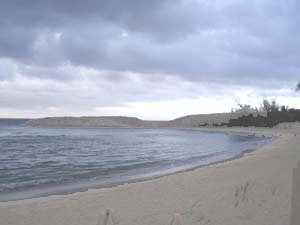Maryland Without Crabs?
Thursday, July 31st, 2008About the author: Lina Younes has been working for EPA since 2002 and chairs EPA’s Multilingual Communications Task Force. Prior to joining EPA, she was the Washington bureau chief for two Puerto Rican newspapers and she has worked for several government agencies.
Lea la versión en español a continuación de esta entrada en inglés.
Some links exit EPA or have Spanish content. ![]()
In my nightly Web surfing, I came across an article on the “Top 25 Things Vanishing From America.” As expected, the loss of some “old technologies” like the VCR, dial-up internet access, phone landlines, analog TV, made the list. However, what struck me enough to write about it in today’s blog was the mention of the Chesapeake Bay Blue Crabs and honey bees.
Maryland has been my home for nearly 28 years. The blue crab, is practically a state icon. I must note that my family and I enjoy eating crabs in many ways. In this era of going “local” in our culinary habits, you would think that living in the Free State, eating crabs is the right thing to do. Yet this Internet article has made me reflect and question—should we keep crabs off the menu for a while?
Overfishing, water pollution and excessive nutrients are threatening the blue crab and aquatic wildlife that live in and around the Chesapeake Bay, the largest estuary in the United States. This important watershed spans six states—Maryland, Virginia, Delaware, Pennsylvania, West Virginia, New York and the nation’s capital, Washington, DC. EPA and its state partners work closely together to accelerate progress towards a healthy Bay. Through the Chesapeake Bay Program, EPA is trying to make a difference in restoring the blue crab habitat by working to improve water quality and submerged aquatic vegetation. In the meantime, the role of setting harvest regulations for the blue crab lies primarily on the states along the Bay.
Whether you’re concerned about the Chesapeake Bay or your local watershed, there are simple steps you can take in your home, school, community or the workplace to protect these precious aquatic resources. For example, conserve water! Don’t pour used motor oil down the drain! Used oil from a single oil change can ruin a million gallons of fresh water—A year’s supply for 50 people. Use greenscaping techniques in your garden. Bottom line—learn and get involved.
¿Maryland sin cangrejos?
Sobre la autor: Lina M. F. Younes ha trabajado en la EPA desde el 2002 y está a cargo del Grupo de Trabajo sobre Comunicaciones Multilingües. Como periodista, dirigió la oficina en Washington de dos periódicos puertorriqueños y ha laborado en varias agencias gubernamentales.
En mis viajes por Internet, encontré un artículo sobre las “Principales 25 cosas que están desapareciendo de América”. Como era de esperarse, la pérdida de algunas “viejas tecnologías” como los VCR, las líneas telefónicas terrestres, la TV análoga figuraban en la lista. Sin embargo, lo que me chocó y motivó a escribir el blog de hoy fue la mención de los cangrejos azules de la Bahía de Chesapeake y las abejas de miel.
Maryland ha sido mi hogar durante casi 28 años. El cangrejo azul es casi un ícono estatal. Debo destacar que a mi familia a mí nos encanta comer cangrejos de diversas formas. En esta era de abogar por los hábitos culinarios locales, uno pensaría que viviendo en Maryland, el comer cangrejos sería aconsejable. Sin embargo, con este artículo del Internet, me he puesto a pensar–¿acaso debemos eliminar los cangrejos del menú por algún tiempo?
La pesca en exceso, la contaminación del agua, y los nutrientes excesivos están amenazando el cangrejo azul y la vida silvestre acuática en y alrededor de la Bahía Chesapeake, el estuario más grande en Estados Unidos. Esta importante cuenca fluvial abarca seis estados—Maryland, Virginia, Delaware, Pensilvania, Virginia Occidental, Nueva York y la capital federal, Washington, DC. EPA y sus socios estatales trabajan estrechamente para acelerar el progreso hacia una bahía saludable. Mediante el Programa de la Bahía de Chesapeake, EPA está tratando de hacer una diferencia en la restauración del hábitat del cangrejo azul al trabajar para mejorar la calidad del agua y la vegetación acuática sumergida. Entretanto, el rol de establecer las regulaciones para la cosecha del cangrejo azul recae primordialmente sobre los estados vecinos a la bahía.
Independientemente de su interés en la Bahía del Chesapeake o su cuenca fluvial local, hay pasos sencillos que puede tomar en su hogar, colegio, comunidad o lugar de trabajo para proteger estos preciados recursos acuáticos. Por ejemplo, ¡conserve agua—cada gota cuenta! ¡No eche el aceite de motor usado por la alcantarilla! El aceite usado de un simple cambio de aceite puede contaminar un millón de galones de agua fresca—el suministro de 50 personas para un año. Utilice técnicas de jardinería verde en su jardín. A fin de cuentas—aprenda y participe activamente en la protección ambiental.

 Each week we write about the science behind environmental protection.
Each week we write about the science behind environmental protection. 
 While I can’t speak for other science writers, I might just have to admit that what I do is easier than creating fiction. There never seems to be a shortage of fascinating stories unfolding at labs and field sites wherever researchers or engineers are running experiments, gathering data, or building the next prototype. And I’ve got the added benefit that my personal interests—the environment and human health—dovetail perfectly with EPA’s mission.
While I can’t speak for other science writers, I might just have to admit that what I do is easier than creating fiction. There never seems to be a shortage of fascinating stories unfolding at labs and field sites wherever researchers or engineers are running experiments, gathering data, or building the next prototype. And I’ve got the added benefit that my personal interests—the environment and human health—dovetail perfectly with EPA’s mission.